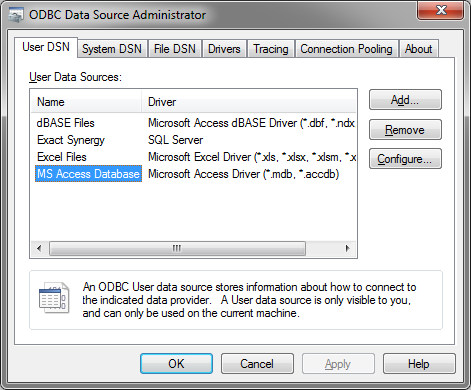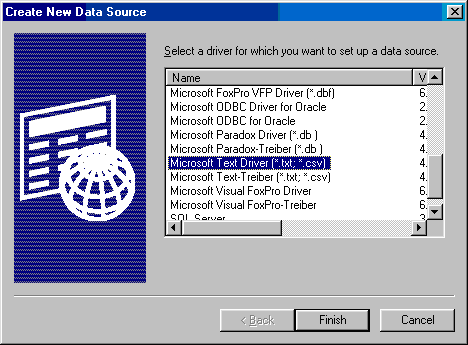ODBC: Difference between revisions
No edit summary |
No edit summary |
||
| Line 4: | Line 4: | ||
Each [[ODBC]] connection has some specific parameters for the database connection. These specific database connection parameters can be configured in the [[ODBC]] driver for that specific database. The configuration of the [[ODBC]] driver can then be stored as a Data Source, which is a configured [[ODBC]] database connection. | Each [[ODBC]] connection has some specific parameters for the database connection. These specific database connection parameters can be configured in the [[ODBC]] driver for that specific database. The configuration of the [[ODBC]] driver can then be stored as a Data Source, which is a configured [[ODBC]] database connection. | ||
== Configuration == | |||
The configuration of the [[ODBC]] connection should be done within the [[Microsoft]] [[Windows]] operating system. | |||
Select | |||
{{menu|Start|Settings|Control Panel|ODBC Data Sources}} | |||
Now the ODBC Data Source Administrator dialog will be shown, which can be used manage the available ODBC Data Sources. | |||
[[Image:Odbc data source administrator.png]] | |||
Then Select {{ScreenElement|Add...}} to add a new ODBC Data Source. | |||
[[Image:Create new data source.png]] | |||
Depending on the required Database connection, the correct driver should be selected. The selected driver will be used to create a new Data Source when the {{ScreenElement|Finish}} button is pressed. Depending on the selected [[ODBC]] driver, a specific driver configuration window will appear. This driver specific configuration window has to be configured to further finalize the [[ODBC]] connection with the correct parameters. | |||
== Specific ODBC Drivers == | |||
An explanation of how to use the [[ODBC]] text-database driver is available on the [[ODBC text setup]] page. | An explanation of how to use the [[ODBC]] text-database driver is available on the [[ODBC text setup]] page. | ||
Revision as of 13:47, 25 November 2010
ODBC is the abbreviation of Open DataBase Connectivity, which is a standard software interface to interact with different Databases.
RadiMation® is often using an ODBC connection to retrieve information from an external database. For example the customer database within RadiMation® can be configured to use an ODBC connection. Most database management systems (like MySQL) provide an ODBC driver, which makes it possible to connect RadiMation® through the ODBC layer with all of those databases.
Each ODBC connection has some specific parameters for the database connection. These specific database connection parameters can be configured in the ODBC driver for that specific database. The configuration of the ODBC driver can then be stored as a Data Source, which is a configured ODBC database connection.
Configuration
The configuration of the ODBC connection should be done within the Microsoft Windows operating system.
Select
-
 Start
Start
-
 Settings
Settings
-
 Control Panel
Control Panel
-
 ODBC Data Sources
ODBC Data Sources
-
-
-
-
Now the ODBC Data Source Administrator dialog will be shown, which can be used manage the available ODBC Data Sources.
Then Select Add... to add a new ODBC Data Source.
Depending on the required Database connection, the correct driver should be selected. The selected driver will be used to create a new Data Source when the Finish button is pressed. Depending on the selected ODBC driver, a specific driver configuration window will appear. This driver specific configuration window has to be configured to further finalize the ODBC connection with the correct parameters.
Specific ODBC Drivers
An explanation of how to use the ODBC text-database driver is available on the ODBC text setup page.
An explanation of the MySQL ODBC driver is available on the: MySQL Connector/ODBC Data Source Configuration page.
Links
- Wikipedia: Open Database Connectivity

